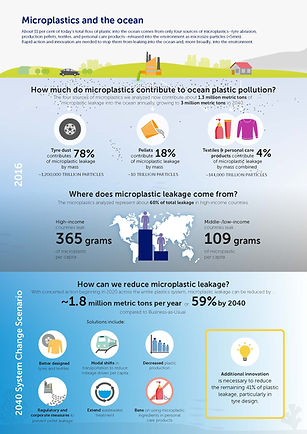
Complex Human-Environmental Systems Simulation Laboratory
Plastic pollution
Plastic pollution is a growing threat to marine and terrestrial ecosystems. The pollution itself is a manifestation of a deeper problem with the way the relevant economic systems, material flows, and environmental protections are currently set up. Prior to this work, the lack of a sufficiently integrated analysis, and dynamic model, led to considerable lack of clarity over the potential for different viable solutions (or components of solutions) to make meaningful impacts. For example, "Is more recycling the answer?". In Phase I of this project (funded by Pew, and in collaboration with Systemiq Ltd), we quantified current plastic use, and projected forward to 2040 the impacts of different feasible scenarios, from a "business as usual" (no change in the projected rising flow of plastic into the ocean), to an extreme intervention resulting in a significant overhaul of the World's plastics systems (the “system change scenario”). The analysis spans plastic production, consumption, collection, and disposal/recycling, and also estimates both environmental pollution levels (aquatic and terrestrial pollution, and greenhouse gas emissions) and a range of economic factors (including associated costs, revenue, employment levels, required investment).
The P2O model
The model is an empirically-informed ODE-based representation of the full plastic supply and use chain. It quantifies the flow of plastic in the global system, and was used in Phase I of this work to compare different possible scenarios between 2016 and 2040 under six scenarios: from no change ("business as usual"), through differing degrees of pre- and post-consumption measures (including increased waste collection rates, more re-use and substitution, greater recycling capacity) through to an overhaul which included all currently feasible components.

Our paper published in Science provides full details of the model and analysis, along with key findings. Reference below.
The aim was to provide global estimates, and as such the global population was split in to archetypes based on eight economic bands, urban/rural context, and by geographical zones (proximity to major water bodies); the calculated plastic flow included three different macro plastic categories ('rigid', 'flexible' and 'multi-material'), plus separate system models for micro-plastic components (tyres, synthetic textiles, pellets and care products). The model was run under six feasible scenarios for change. Parameter uncertainty was included through Monte Carlo sampling.
Full technical details of the model can be found in the supplementary online material of the Lau et al. (2020) paper - see reference below. The computational model was created by Richard Bailey, and is available on Github.
Core components of the P2O model for macro-plastic components
Core findings from Phase I
-
if no action is taken to address the projected growth in plastic production and use, the amount of plastic entering the ocean each year is expected to grow from 11 million metric tons to 29 million metric tons over the next 20 years, equivalent to nearly 50 kilograms of plastic for each metre of coastline worldwide (the cumulative amount of plastic in the ocean by 2040 could reach 600 million tons)
-
current commitments by government and industry will reduce the amount of plastic flowing into the ocean only by 7 per cent by 2040
-
without meaningful change, about 4 billion people worldwide are likely to be without organized waste collection services by 2040, contributing significantly to the projected amount of ocean plastic pollution; closing this gap would require connecting more than 500,000 people to collection services per day until 2040
-
solutions that could cut this volume by more than 80 per cent using technologies that are available today, if key decision-makers are willing to make systemwide changes
-
reducing growth in plastic production and consumption, substituting some plastics with alternatives such as paper and compostable materials, designing products and packaging for recycling, expanding waste collection rates in middle- and low-income countries, increasing recycling, and reducing plastic waste exports. In addition to improving ocean health, adopting the changes outlined in the report could generate savings of $70 billion for governments by 2040, relative to business-as-usual; reduce projected annual plastic-related greenhouse gas emissions by 25 per cent; and create 700,000 jobs
-
an unprecedented level of action and will still leave more than 5 million metric tons leaking into the ocean each year in 2040. Fully eliminating the flow of ocean plastic pollution will require dramatically increasing innovation and investment, with significant technological advances, new business models, and a greater emphasis on research and development


Two key graphics from the "Breaking the plastic wave" report.
Ongoing work: Phase II
Phase II of this work is currently underway. Further refinements and analytical methods are being added to the model, and a 'user-friendly' interface to the model is being produced. This work will provide free access to the model and its capabilities to users from governments, NGOs, Universities, and others, around the World. Phase II is a collaboration between Richard Bailey and Pew, and involves close working partnerships with several countries, helping in their attempts to understand the wide impacts of potential interventions aimed at reducing plastic pollution.
Further details of this work will be provided in future. Anyone interested is encouraged to get in touch.
Outputs
Publications:
-
Lau, W.W.Y., Shiran, Y., Bailey, R.M. et al. (2021) Evaluating scenarios toward zero plastic pollution. Science Vol. 369, Issue 6510, pp. 1455-1461. DOI: 10.1126/science.aba9475 [available here]
-
Breaking the plastic wave report [available here]
-
Pew summary [available here]
Report launch event :
The launch event was live-streamed on YouTube. A recording can be found here.